| ________________
CM . . . . Volume XVII Number 7. . . .October 15, 2010. 
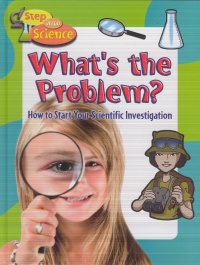 |
What’s the Problem? How to Start Your Scientific Investigation. (Step into Science).
Kylie Burns.
St. Catharines, ON: Crabtree, 2010.
32 pp., pbk. & hc., $9.95 (pbk.), $20.76 (RLB.).
ISBN 978-0-7787-5173-1 (pbk.), ISBN 978-0-7787-5158-8 (RLB.).
Subject Headings:
Science-Methodology-Juvenile literature.
Science-Experiments-Juvenile literature.
Grades 3-6 / Ages 8-11.
Review by Barbara McMillan.
*/4
|
| |
|
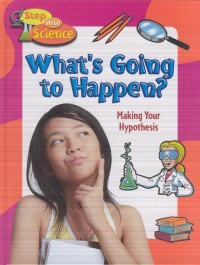 |
What’s Going to Happen? Making Your Hypothesis. (Step into Science).
Paul Challen.
St. Catharines, ON: Crabtree, 2010.
32 pp., pbk. & hc., $9.95 (pbk.), $20.76 (RLB.).
ISBN 978-0-7787-5172-4 (pbk.), ISBN 978-0-7787-5157-1 (RLB.).
Subject Headings:
Science-Methodology-Juvenile literature.
Science-Experiments-Juvenile literature.
Hypothesis-Juvenile literature.
Grades 3-6 / Ages 8-11.
Review by Barbara McMillan.
*/4
|
| |
|
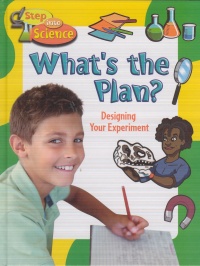 |
What’s the Plan? Designing Your Experiment. (Step into Science).
Natalie Hyde.
St. Catharines, ON: Crabtree, 2010.
32 pp., pbk. & hc., $9.95 (pbk.), $20.76 (RLB.).
ISBN 978-0-7787-5169-4 (pbk.), ISBN 978-0-7787-5154-0 (RLB.).
Subject Headings:
Science-Methodology-Juvenile literature.
Science-Experiments-Juvenile literature.
Grades 3-6 / Ages 8-11.
Review by Barbara McMillan.
*/4
|
| |
|
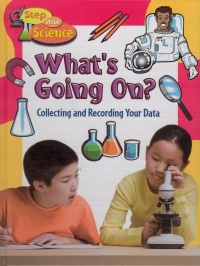 |
What’s Going On? Collecting and Recording Your Data. (Step into Science).
Kylie Burns.
St. Catharines, ON: Crabtree, 2010.
32 pp., pbk. & hc., $9.95 (pbk.), $20.76 (RLB.).
ISBN 978-0-7787-5170-0 (pbk.), ISBN 978-0-7787-5155-7 (RLB.).
Subject Headings:
Science-Methodology-Juvenile literature.
Science-Experiments-Juvenile literature.
Grades 3-6 / Ages 8-11.
Review by Barbara McMillan.
*/4
|
| |
|
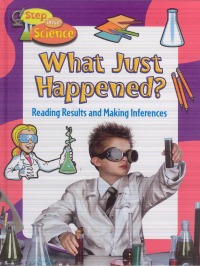 |
What Just Happened? Reading Results and Making Inferences. (Step into Science).
Paul Challen.
St. Catharines, ON: Crabtree, 2010.
32 pp., pbk. & hc., $9.95 (pbk.), $20.76 (RLB.).
ISBN 978-0-7787-5171-7 (pbk.), ISBN 978-0-7787-5156-4 (RLB.).
Subject Headings:
Science-Methodology-Juvenile literature.
Science-Experiments-Juvenile literature.
Grades 3-6 / Ages 8-11.
Review by Barbara McMillan.
*/4
|
| |
|
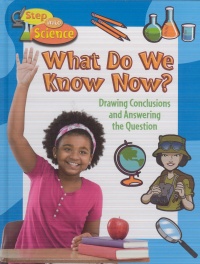 |
What Do We Know Now? Drawing Conclusions and Answering the Question. (Step into Science).
Robin Johnson.
St. Catharines, ON: Crabtree, 2010.
32 pp., pbk. & hc., $9.95 (pbk.), $20.76 (RLB.).
ISBN 978-0-7787-5168-7 (pbk.), ISBN 978-0-7787-5153-3 (RLB.).
Subject Headings:
Science-Methodology-Juvenile literature.
Science-Experiments-Juvenile literature.
Grades 3-6 / Ages 8-11.
Review by Barbara McMillan.
*/4
|
| |
|

excerpt:
Have you even been in an elevator? The scientific method is like an elevator - you enter at the first floor and take the elevator up. The elevator passes one floor at a time, and you get closer to your final stop. Sometimes, however, the journey takes you back down before you continue on to reach your destination.
In the same way, following each step in the scientific method is important for making scientific discoveries. Sometimes, though, scientists have to stop, go back, and think again before they continue. (p. 4 of each book in the series)
scientific method The way to do an experiment properly. (p. 31, Glossary of each book in the series)
The “Step into Science” series was developed to help children understand the processes associated with experimental work in science. As the titles and subtitles suggest, each of the six books in the series focuses upon a particular aspect of scientific research and what the authors refer to as “The Scientific Method.” As with other Crabtree science books for readers between the ages of eight and eleven, the 32 pages include a table of contents, glossary, index, at least two opportunities to carry out a pre-planned investigation, historical information, and a vibrant layout that includes textboxes of various sizes and colours and numerous stock images from Shutterstock, Getty Images, Corbis and the like. As good at this may seem in an era of inquiry in science learning, there are problems with the information presented in the series.
It has long been know by practicing scientists, science historians, and philosophers of science that there are as many ways of doing science as there are scientists. Recently, science educator William McComas presented a set of nine basic elements to be taught in school science that distinguishes the domain of science from all other disciplines. The first of these elements focuses upon science as an empirical data-driven pursuit. The second states, “There is no single step-by-step scientific method by which all science is done” (2004, p. 25). McComas, in fact, refers to studies of scientists at work that reveal idiosyncratic ways of coming to and defining problems and approaching research. The “scientific method” is anything but stepwise and routine. In this context, one wonders why the science education consultant for Crabtree’s “Step into Science” series, Suzy Gazlay, promotes a process that fails to represent how science functions and by doing so perpetuates a misconception about the nature of science. Unfortunately, this is not the only problem with the series.
In Paul Challen’s What’s Going to Happen? readers are told that scientists don’t answer questions by guessing what the answer may be; they construct hypotheses. An hypothesis is defined as “a prediction about what an experiment will prove” (p. 4), and Challen cautions young science students to “make sure your hypothesis is a statement you will be able to prove or disprove” (p. 13). This understanding of a scientific hypothesis is maintained in Challen’s writing of What Just Happened? (p. 26), and in Robin Johnson’s What Do We Now Know? Johnson writes, “[t]ake time to make a conclusion, and think hard about your data. Make sure your research really proves – or disproves – your hypothesis. To disprove a hypothesis means to show that it isn’t true” (p. 7). At issue here is the notion that the hypotheses of scientists can be proved or disproved. Scientists do form hypotheses, and scientists do test hypotheses, but the data they collect and interpret can only support or fail to support an hypothesis. Science cannot prove anything because the problem of induction makes “proof” in science impossible. That is, we can say that all crows are black, but a yellow crow could exist that no one has yet observed. Predictions, on the other hand, are statements of what a future event will be. Rather than being tests of generalizations (all solids that are soluble in water will dissolve more quickly in hot water than cold water), predictions are tests of specific cases (these four sugar cubes will dissolve more quickly in hot water than cold water). As such, when predictions are tested, the results will show that the prediction was either correct or incorrect. The majority of scientific tests carried out in elementary classrooms are simple prediction tests.
Given that each book represents one of the six steps in the so called “Scientific Method,” there is a large, and unfortunate, overlap in content. It’s rather difficult, for example, to address the topic of Step 4 “collecting and recording your data” in What’s Going On? without also addressing research questions (Step 1, What’s the Problem?) , informed predictions (Step 2, What’s Going to Happen?), and experimental design (Step 3, What’s the Plan?). This is especially evident in “The Scientific Method”, “Let’s Experiment” and “Keeping a Journal” sections of the six books. It may have been more coherent and meaningful for young readers if authors Burns, Challen, Hyde, and Johnson had worked together to write one book about the processes of scientific investigation that included uncommon, yet relevant, experiments. In so doing, the authors may not have missed opportunities for experiments that would help to clarify particular processes necessary in scientific work while involving readers in authentic science. In this way, having read about the important role of specific and measurable questions in What’s the Problem? (pp. 5-13), readers would be given opportunities to construct scientific questions for a particular problem rather than carry out an investigation that simply asks, What sort of filter do you think they [water companies] might use?” Likewise, in What’s the Plan?, rather than testing the strength of one magnet versus two magnets after reading about dependent variables, independent variables. and controls, readers would have opportunities to carry out an investigation that requires the identification of all variables, the one variable that will be manipulated, the responding variable that will be measured, the variables that will be the same for all test samples, and the control. Similarly, after learning about the need for standard units of measurement in What’s Going On? (pp. 12-13), readers would be invited to conduct an experiment that requires measured data to be collected, recorded, and interpreted rather than fill a beverage glass “almost to the top”, “half full”, or “one-fourth” with soda pop in a “Dancing Raisins” experiment (pp. 14-15).
Owing to oversights such as these, the aforementioned redundancies and misconceptions, and the fact that the series would need to be purchased in its entirety to understand important processes involved in scientific research, it’s difficult to recommend Crabtree’s “Step into Science” series. There are, without question, good aspects within each book. One need only read Challen’s discussion of data interpretation in What’s Just Happened? to realize the importance of record keeping and drawing inferences from data. Nonetheless, it would be more beneficial for students of science if their parents and teachers logged on to websites such as Understanding Science: How Science Really Works at http://undsci.berkeley.edu/index.php and modeled and discussed why these processes are integral to scientific work and the construction of new science knowledge.
Not Recommended.
Barbara McMillan is a teacher educator and a professor of science education in the Faculty of Education, the University of Manitoba.

To comment on this title or this review, send mail to
cm@umanitoba.ca.
Copyright © the Manitoba Library Association. Reproduction for personal use is permitted only if this copyright notice is maintained. Any other reproduction is prohibited without permission.
NEXT REVIEW |
TABLE OF CONTENTS FOR THIS ISSUE- October 15, 2010.
AUTHORS |
TITLES |
MEDIA REVIEWS |
PROFILES |
BACK ISSUES |
SEARCH |
CMARCHIVE |
HOME |





